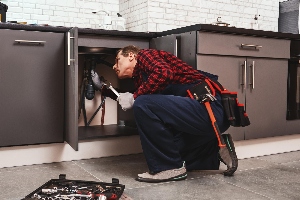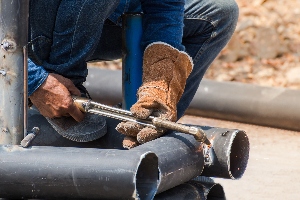Water leaks in residential spaces can lead to significant damage, costly repairs, and wastage of resources. Detecting leaks early is key in preventing these undesirable outcomes. As a homeowner, you should be aware of the various methods and technologies available for leak detection to safeguard your property.
With advancements in home maintenance technology, there are multiple options at your disposal for monitoring your home's water system. Modern smart water leak detectors offer real-time alerts and detailed monitoring, potentially saving you from extensive water damage by alerting you to leaks as soon as they start. Using sensors and home automation systems, these devices can provide you with peace of mind knowing that your home is protected against unexpected water issues.
When selecting a leak detection system, consider factors like the size of your home, the complexity of your water system, and the level of investment you're ready to make. Professional installation services can ensure that your system is set up effectively, while consumer-grade products might offer a more hands-on approach for those who prefer a DIY solution. Whatever your choice, staying proactive in leak detection is a smart move to maintain the integrity of your home’s infrastructure.
Fundamentals of Residential Leak Detection
Effective leak detection in your home is crucial in preventing water damage and maintaining the integrity of your plumbing system.
Types of Water Leaks
There are two primary types of water leaks that you could encounter in your residence:
- Visible Leaks: These leaks are easy to notice and include dripping faucets, leaking water heaters, and overflowing toilets. Visible indicators include puddles or water stains.
- Hidden Leaks: These occur in places you can't easily see, such as inside walls, below floors, or underground. These typically manifest through unusually high water bills, musty odors, or mold growth.
Common Causes of Residential Leaks
Your home's water leaks may stem from:
- Aging Materials: Pipes and washers can deteriorate over time, leading to failures.
- High Water Pressure: Excessive pressure can stress pipes, resulting in leaks.
- Corrosion: Pipe corrosion can cause leaks, especially in older homes with metal piping.
- Extreme Temperatures: Freezing can lead to pipe bursts, while heat can wear out fixtures and seals.
Recognizing the types of leaks and their common causes helps you to take swift and appropriate action to address any issues that arise.
Detection Techniques
In residential settings, identifying leaks promptly can prevent significant water damage. Choose the right detection technique based on the situation at hand, whether it be a simple manual check or using sophisticated technology.
Manual Inspection Methods
You can perform a visual check for any signs of moisture on walls, ceilings, or floors. Check for mold, mildew, or water stains, which can indicate the presence of leaks even if they are not directly visible.
Acoustic Leak Detection
An acoustic leak detector amplifies the sound of water escaping from pipes, allowing you to pinpoint the location of a leak. Professionals often use this method as it's effective in detecting even small leaks within walls or underground.
Thermal Imaging
Thermal imaging cameras detect temperature differences in walls and floors to locate leaks. Cool spots may suggest the presence of moisture from a leaky pipe.
Moisture Meters
A moisture meter can help you detect high levels of moisture in building materials. It's a non-invasive tool that you press against a surface to get a reading of the moisture level, which can suggest the presence of a leak nearby.
Pressure Testing
Pressure testing involves adding pressure to your pipes and then monitoring a pressure gauge for any drops. A decrease in pressure usually means there's a leak in your plumbing system.
Smart Water Sensors
Smart water sensors offer real-time monitoring and can send alerts to your phone if a leak is detected. They are installed in potential leak points and are ideal for ongoing leak surveillance.
Remember, early detection and repair of leaks can save you from costly water damage repairs and reduce waste of water resources.
Locating Leaks in Different Areas
Effective leak detection in a residential setting depends on accurately pinpointing the source of the water escape. The approaches to finding leaks vary based on whether they are inside your home, in outdoor spaces, or below ground.
Indoor Leak Detection
To identify indoor leaks, start by inspecting common problem areas like under sinks, around toilets, and near water heaters. Signs such as warped flooring, discolored walls, or mold indicate moisture may be coming from hidden pipes. Pay special attention to:
- Appliances: Check connections to dishwashers and washing machines.
- Bathrooms: Look for water around showers, tubs, and toilets.
- Kitchen: Examine the area under the sink and around the refrigerator if it has a water dispenser or ice maker.
Outdoor Leak Detection
Outdoor leaks can often be spotted by soggy patches in your yard or unexpected plant growth. Key areas to monitor include:
- Hoses and Spigots: Ensure connections are tight and hoses are not leaking.
- Irrigation Systems: Check for broken sprinkler heads or damp areas along the system.
- Pools and Fountains: Look for cracks or wet spots in the surrounding areas.
Underground Leak Detection
Underground leaks require a careful approach, as they are less visible and can cause significant damage. Techniques for locating them include:
- Water Meter Check: Turn off all water inside and out, and see if the meter continues to run.
- Professional Assessment: Consider hiring a leak detection service with specialized equipment to locate the leak without invasive digging.
Employing these methods helps you target the specific leak location and take the appropriate steps to rectify the issue.
One Call Plumbing specializes in leak detection and prevention.












